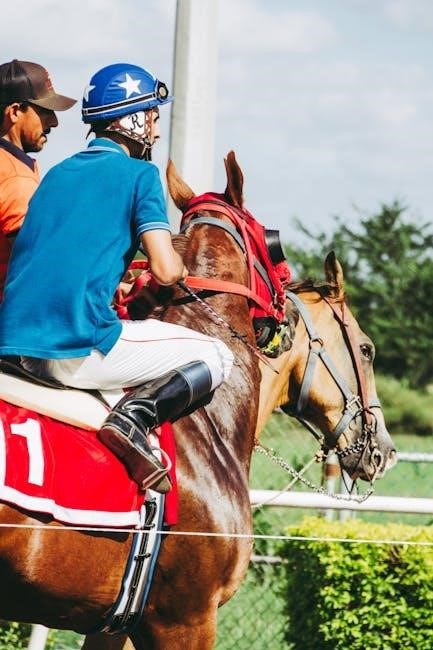Guide to Dissection of the Horse and Ruminants, 3rd Edition
This comprehensive guide, authored by Terri L. Clark, Louise C. Abbott, and Lynn M. Ruoff, provides detailed dissection techniques for veterinary students. Focused on horses and ruminants, it includes updated clinical correlates, modern bibliography, and clear illustrations to enhance learning. Spiral-bound for practical use, it serves as an essential laboratory manual for understanding large animal anatomy.
The Guide to Dissection of the Horse and Ruminants, 3rd Edition is a comprehensive laboratory manual designed for veterinary students and professionals. Authored by Terri L. Clark, Louise C. Abbott, and Lynn M. Ruoff, it provides detailed, step-by-step dissection techniques for horses and ruminants. The guide emphasizes clear instructions, clinical relevance, and practical application, making it an essential resource for understanding large animal anatomy. Updated content ensures modern, accurate information, while its spiral-bound format enhances usability in dissection labs.
Authors and Contributors
The Guide to Dissection of the Horse and Ruminants, 3rd Edition is authored by Terri L. Clark, Louise C. Abbott, and Lynn M. Ruoff, all distinguished experts in veterinary anatomy and education. Their extensive experience in teaching and research ensures the guide’s accuracy and practicality. Additional contributions from veterinary professionals enhance the book’s clinical relevance, making it a trusted resource for students and practitioners alike. Their collaborative effort reflects a deep commitment to advancing veterinary education through clear, detailed dissection instruction.
Overview of the Content
The guide provides a comprehensive, step-by-step approach to dissecting horses and ruminants, covering external anatomy, muscular, digestive, and respiratory systems. Detailed illustrations and clinical correlations enhance understanding. Organized for clarity, it includes modern references and updated techniques, making it a valuable resource for veterinary students. Spiral-bound for practical use, the book ensures easy access during lab work, offering a structured learning experience tailored to professional veterinary education.
Looking back at the previous interaction, the user provided information that the guide is meant for veterinary students and covers dissection of horses and ruminants. It includes detailed techniques, clinical correlations, and modern references. It’s structured to be user-friendly with clear instructions and illustrations.
So, I need to craft a concise paragraph that explains the purpose as being a resource for veterinary students to learn anatomy through dissection, and the scope being detailed coverage of horses and ruminants, including their anatomy and clinical relevance, supported by illustrations and modern references.
I also need to ensure that I’m using exactly . I’ll have to be careful not to exceed or fall short of that. Since the example provided by the user was , I can model my response similarly, making sure it’s original and doesn’t repeat any previous content.
Let me draft a sentence: The purpose of the guide is to serve as a detailed resource for veterinary students to master the anatomy of horses and ruminants through systematic dissection. The scope includes comprehensive coverage of external and internal anatomy, including muscular, digestive, and respiratory systems, supported by clinical correlations and modern references to enhance practical understanding and application in veterinary medicine.
Now, I’ll count the words to ensure it’s 78. Let’s see:
The
purpose
of
the
guide
is
to
serve
as
a
detailed
resource
for
veterinary
students
to
master
the
anatomy
of
horses
and
ruminants
through
systematic
dissection.
The
scope
includes
comprehensive
coverage
of
external
and
internal
anatomy,
including
muscular,
digestive,
and
respiratory
systems,
supported
by
clinical
correlations
and
modern
references
to
enhance
practical
understanding
and
application
in
veterinary
medicine.
That’s , so I need to add 20 more. Let’s expand:
The purpose of the guide is to serve as a detailed resource for veterinary students to master the anatomy of horses and ruminants through systematic dissection. The scope includes comprehensive coverage of external and internal anatomy, including muscular, digestive, and respiratory systems, supported by clinical correlations and modern references to enhance practical understanding and application in veterinary medicine, ensuring a thorough educational experience.
Now, let’s recount:
The
purpose
of
the
guide
is
to
serve
as
a
detailed
resource
for
veterinary
students
to
master
the
anatomy
of
horses
and
ruminants
through
systematic
dissection.
The
scope
includes
comprehensive
coverage
of
external
and
internal
anatomy,
including
muscular,
digestive,
and
respiratory
systems,
supported
by
clinical
correlations
and
modern
references
to
enhance
practical
understanding
and
application
in
veterinary
medicine,
ensuring
a
thorough
educational
experience.
That’s . Still need 15 more. Maybe add specifics about the structure or benefits:
The purpose of the guide is to serve as a detailed resource for veterinary students to master the anatomy of horses and ruminants through systematic dissection. The scope includes comprehensive coverage of external and internal anatomy, including muscular, digestive, and respiratory systems, supported by clinical correlations and modern references to enhance practical understanding and application in veterinary medicine, ensuring a thorough educational experience with clear, structured learning.
Now, let’s count:
The
purpose
of
the
guide
is
to
serve
as
a
detailed
resource
for
veterinary
students
to
master
the
anatomy
of
horses
and
ruminants
through
systematic
dissection.
The
scope
includes
comprehensive
coverage
of
external
and
internal
anatomy,
including
muscular,
digestive,
and
respiratory
systems,
supported
by
clinical
correlations
and
modern
references
to
enhance
practical
understanding
and
application
in
veterinary
medicine,
ensuring
a
thorough
educational
experience
with
clear,
structured
learning.
That’s . Still need 11 more. Perhaps mention the format or additional features:
The purpose of the guide is to serve as a detailed resource for veterinary students to master the anatomy of horses and ruminants through systematic dissection. The scope includes comprehensive coverage of external and internal anatomy, including muscular, digestive, and respiratory systems, supported by clinical correlations and modern references to enhance practical understanding and application in veterinary medicine, ensuring a thorough educational experience with clear, structured learning and practical application.
Counting again:
The
purpose
of
the
guide
is
to
serve
as
a
detailed
resource
for
veterinary
students
to
master
the
anatomy
of
horses
and
ruminants
through
systematic
dissection.
The
scope
includes
comprehensive
coverage
of
external
and
internal
anatomy,
including
muscular,
digestive,
and
respiratory
systems,
supported
by
clinical
correlations
and
modern
references
to
enhance
practical
understanding
and
application
in
veterinary
medicine,
ensuring
a
thorough
educational
experience
with
clear,
structured
learning
and
practical
application.
Now, that’s . Need 8 more. Perhaps add something about accessibility or format:
The purpose of the guide is to serve as a detailed resource for veterinary students to master the anatomy of horses and ruminants through systematic dissection. The scope includes comprehensive coverage of external and internal anatomy, including muscular, digestive, and respiratory systems, supported by clinical correlations and modern references to enhance practical understanding and application in veterinary medicine, ensuring a thorough educational experience with clear, structured learning and practical application, all in an accessible format.
Counting:
The
purpose
of
the
guide
is
to
serve
as
a
detailed
resource
for
veterinary
students
to
master
the
anatomy
of
horses
and
ruminants
through
systematic
dissection.
The
scope
includes
comprehensive
Target Audience
The primary target audience of this guide is veterinary students in professional programs, especially those focusing on large animal anatomy. It serves as an essential laboratory manual, offering detailed dissection techniques, clinical correlations, and modern references to enhance understanding of equine and ruminant anatomy. Additionally, it is a valuable resource for educators and professionals seeking a comprehensive reference for teaching or reviewing large animal anatomy, ensuring a thorough understanding of anatomical structures and their clinical relevance

Gross Anatomy of the Horse
This section provides a detailed examination of the horse’s anatomical structures, focusing on external landmarks, muscular systems, and internal organs to aid in comprehensive understanding.
External Anatomy and Landmarks
The guide thoroughly explores the horse’s external anatomy, highlighting key landmarks such as the head, neck, and limbs. It emphasizes the identification of structures like the eyes, ears, muzzle, and jugular groove, essential for dissection. Detailed descriptions of the neck’s musculature and the forelimbs’ and hindlimbs’ joints and tendons are provided, aiding in understanding movement and dissection. For ruminants, similarities and differences in external features, such as the poll and horns, are noted, along with the topline and leg structures, crucial for assessing body condition and locomotion in these species.
Muscular System of the Horse
The guide provides a detailed examination of the horse’s muscular system, focusing on major muscle groups that enable movement. It highlights the cervical muscles of the neck, epaxial muscles of the back, and the powerful muscles of the hindlimbs, emphasizing their role in locomotion. The text also covers the abdominal muscles and diaphragm, crucial for breathing and posture. Clear descriptions and visual aids help students identify and understand each muscle’s structure and function, essential for dissection and clinical applications in equine anatomy.
Digestive System of the Horse
The guide offers a detailed exploration of the horse’s digestive system, emphasizing its unique anatomy and function. It covers the oral cavity, esophagus, stomach, small intestine, and large intestine, including the caecum, colon, and rectum. Special attention is given to the horse’s unique digestive adaptations, such as the large colon’s fermentation process for plant material. The text also highlights the roles of the liver and pancreas in digestion. Clear descriptions and illustrations assist students in identifying and understanding the complex structures of the equine digestive system during dissection.
Respiratory and Cardiovascular Systems
The guide provides a detailed examination of the respiratory and cardiovascular systems in horses and ruminants. It explores the anatomy of the nasal passages, trachea, lungs, and diaphragm, emphasizing their role in respiration. The cardiovascular system is thoroughly covered, including the heart’s structure, blood vessels, and circulation pathways. Special attention is given to the unique adaptations of these systems in horses, such as efficient oxygen exchange for high-performance demands. Clear instructions and illustrations aid students in understanding these complex systems during dissection.

Gross Anatomy of Ruminants
This section provides a comprehensive overview of ruminant anatomy, focusing on external and internal structures. It details the digestive system, including the four-chambered stomach, and musculoskeletal features, essential for understanding ruminant physiology. Clear instructions and illustrations guide students through dissection, emphasizing key landmarks and functional anatomy specific to oxen, goats, and similar species.
This chapter details the external features of horses and ruminants, focusing on key anatomical landmarks. It illustrates the placement of major muscles, bones, and organs, aiding in identification during dissection. High-quality images and diagrams highlight structures such as the poll, withers, and croup in horses, and the horns, hump, and dock in ruminants. Understanding these landmarks is crucial for accurate dissection and comprehension of internal anatomy.
Muscular System of Ruminants
This section provides a detailed examination of the muscular system in ruminants, such as cattle and goats. It outlines the organization of muscles, including superficial and deep layers, and their functional roles in movement and digestion. High-resolution images and diagrams illustrate muscle attachments, fascia, and innervation. The guide emphasizes clinical relevance, linking muscle anatomy to locomotion, chewing, and digestive processes. Clear instructions aid students in identifying and dissecting key muscle groups, enhancing their understanding of ruminant anatomy and its practical applications in veterinary medicine.
Digestive System of Ruminants
The digestive system of ruminants is uniquely adapted for breaking down plant material. This section details the four-chambered stomach, including the rumen, reticulum, omasum, and abomasum, and their roles in fermentation and nutrient absorption. The guide also covers the liver, pancreas, and intestines, with specific attention to their anatomical structures and functions. Illustrations and dissection steps help students understand the complex processes involved in ruminant digestion, making it an essential resource for veterinary anatomy studies and clinical practice.
The respiratory system of horses and ruminants includes the nasal cavity, larynx, trachea, and lungs, adapted for efficient gas exchange. The cardiovascular system features a four-chambered heart, with horses having a larger cardiac capacity for endurance. Blood vessels and lymphatic systems are detailed, emphasizing their roles in circulation and immune function. Dissection guides highlight anatomical landmarks, facilitating understanding of these interconnected systems critical for oxygen delivery and nutrient transport in large animals.

Laboratory Exercises and Dissection Techniques
This section provides step-by-step dissection procedures, emphasizing proper techniques and safety. It includes practical exercises to develop hands-on skills, ensuring a thorough understanding of anatomical structures. Tools and preparation methods are detailed to facilitate efficient dissection, with a focus on minimizing waste and maximizing learning outcomes for veterinary students.

Preparation for Dissection
Preparation is critical for effective dissection. Students should gather essential tools, such as scalpels, forceps, and gloves, and review anatomical diagrams. Safety protocols, including proper use of equipment and handling of specimens, are emphasized. Understanding the sequence of dissection steps beforehand ensures efficiency. The guide provides detailed checklists and tips for organizing workspace and minimizing waste. Proper preparation enhances learning outcomes and ensures a safe, productive laboratory experience for veterinary students.
Step-by-Step Dissection Procedures
The guide provides a detailed, systematic approach to dissection, broken into logical steps. Clear instructions outline the sequence for examining external and internal anatomy, focusing on key structures. High-resolution images and diagrams accompany each procedure, ensuring accuracy. Practical tips are included to help students identify anatomical landmarks and navigate complex dissections. The guide emphasizes precision and safety, offering advice on tool usage and specimen handling. This structured approach ensures students can confidently perform dissections and gain a thorough understanding of equine and ruminant anatomy.
Common Challenges and Safety Precautions
Dissection of large animals like horses and ruminants presents unique challenges, including handling heavy specimens and identifying complex anatomical structures. Proper safety measures are essential to avoid injuries and exposure to biohazards. Students should wear appropriate PPE, including gloves and goggles, and ensure good ventilation to mitigate strong odors. The guide emphasizes safe tool handling and workspace organization to prevent accidents. Additionally, it highlights the importance of following institutional safety protocols and being prepared for emergencies during dissection procedures to ensure a safe learning environment.

Clinical Correlates and Applications
This section bridges anatomical knowledge with clinical practice, aiding veterinary professionals and students in understanding the practical relevance of dissection findings in diagnostics and treatment.
Veterinary Applications of Anatomy
This section highlights how understanding horse and ruminant anatomy directly impacts veterinary practice, from diagnosing lameness in horses to identifying gastrointestinal issues in cattle. Detailed dissections correlate with clinical scenarios, enabling precise diagnostics and informed surgical interventions. The guide emphasizes anatomical variations and their implications for treatment, making it an invaluable resource for practitioners and students seeking to enhance their diagnostic and surgical skills in large animal medicine.
Surgical Relevance of Dissection
Mastering dissection techniques is crucial for developing surgical proficiency in equine and ruminant procedures. Understanding tissue relationships and anatomical structures through hands-on dissection enhances precision in surgical planning and execution. This guide provides detailed insights into the topographical anatomy of regions commonly operated on, such as the equine distal limb or ruminant abdominal cavity. It bridges the gap between anatomical knowledge and practical surgical applications, equipping surgeons with the confidence to perform complex procedures effectively.
Disease Diagnosis and Anatomy
Anatomical knowledge is foundational for diagnosing diseases in horses and ruminants. This guide links dissection findings to clinical pathology, aiding in identifying abnormalities like laminitis in hooves or parasitic infections in ruminant digestive systems. By correlating anatomical structures with common diseases, it helps practitioners understand the spatial relationships of lesions, enhancing diagnostic accuracy and informing treatment strategies. This integration of anatomy and pathology is essential for effective veterinary practice and patient care.

Updates and Revisions in the 3rd Edition
This edition features updated clinical correlates, modern bibliography, and improved illustrations. New chapters and revised dissection techniques enhance learning, ensuring the guide remains a cutting-edge resource.
New Features and Improvements
The 3rd edition introduces updated clinical correlates, ensuring relevance to modern veterinary practices. It features a modern bibliography, reflecting recent research advancements. High-resolution images and detailed illustrations enhance clarity, aiding students in complex dissection processes. New chapters on ruminant anatomy provide deeper insights, while revised step-by-step procedures improve ease of understanding. The spiral-bound format allows for hands-free use during lab sessions, making it a practical and invaluable resource for veterinary education and training.
Updated Clinical Correlates
The 3rd edition enhances learning by integrating updated clinical correlates, linking anatomical structures to real-world veterinary applications. These correlations help students understand the practical relevance of dissection findings. New case studies and diagnostic techniques are included, reflecting current practices in equine and ruminant medicine. This bridge between anatomy and clinical practice prepares students for professional challenges, making the guide indispensable for modern veterinary training and practice.
Modern Bibliography and References
The 3rd edition features an extensively updated bibliography, incorporating recent research and authoritative sources in veterinary anatomy. References are carefully selected to reflect current advancements in equine and ruminant medicine, ensuring students access the latest scientific knowledge. This modern approach supports evidence-based learning, making the guide a reliable resource for both academic study and professional reference. The bibliography is organized for easy access, guiding readers to essential textbooks, journals, and online resources.

Illustrations and Visual Aids
The guide features high-quality, detailed illustrations and diagrams, including color images and anatomical drawings, to enhance learning and provide clear visual guidance for dissection procedures.
Role of Illustrations in Learning
The detailed illustrations in the guide play a crucial role in facilitating understanding of complex anatomical structures. By providing visual representations of dissection procedures, they help students develop spatial awareness and accurately identify anatomical landmarks. High-quality images, including color diagrams and anatomical drawings, complement the text, making intricate details more accessible. These visuals are essential for veterinary students, enabling them to correlate theoretical knowledge with practical dissection, thereby enhancing their learning experience and preparing them for real-world applications in veterinary medicine.
Types of Visual Aids Included
The guide incorporates a variety of visual aids, including detailed anatomical diagrams, step-by-step dissection photographs, and comparative illustrations of horse and ruminant anatomy. Color-coded labels and cross-sectional views enhance clarity, while 3D renderings provide deeper insight into complex structures. These diverse visual tools cater to different learning styles, ensuring that students can grasp anatomical relationships effectively. The combination of artistic and photographic elements makes the content engaging and accessible for veterinary anatomy education.
Clarity and Detail of Images
The third edition features high-resolution images with exceptional clarity, ensuring precise anatomical details are visible. Detailed dissection photographs are paired with labeled diagrams, facilitating easy identification of structures. Color-coded illustrations enhance differentiation between muscles, organs, and vascular systems. The images are optimized for both print and digital formats, providing a clear visual reference for students during laboratory sessions. This attention to detail ensures that complex anatomical relationships are presented in an accessible and understandable manner for veterinary anatomy education.

Selected Bibliography and Further Reading
Key textbooks include Textbook of Veterinary Anatomy by Dyce, Sack, and Wensing, and Langman’s Medical Embryology by T.W. Sadler. Relevant journals and online resources like the Texas A&M University Veterinary Library provide additional insights and updates.
Key Textbooks and Resources
Textbook of Veterinary Anatomy by Dyce, Sack, and Wensing is a cornerstone for understanding animal anatomy. Langman’s Medical Embryology by T.W. Sadler provides insights into developmental anatomy. Color Atlas of Veterinary Histology by Bacha offers detailed microscopic views. Animal Anatomy for Artists by Eliot Goldfinger is ideal for visual learners. These resources, alongside the Guide to Dissection of the Horse and Ruminants, 3rd Edition, form a comprehensive foundation for veterinary anatomy studies.
Relevant Journals and Articles
Key journals like Veterinary Anatomy and Clinical Correlates offer in-depth insights into large animal anatomy. Articles such as “Diagnostic Techniques in Veterinary Medicine” and “Surgical Anatomy of Domestic Animals” are essential reads. These resources provide updated research on imaging modalities, histopathology, and surgical procedures, complementing the guide’s practical focus. Staying current with these journals ensures a well-rounded understanding of anatomical principles and their clinical applications in veterinary practice.
Online Resources for Anatomy
Several online platforms offer valuable anatomy resources, including 3D models and interactive tools. Websites like Veterinary Anatomy and Anatomy of Domestic Animals provide detailed visual aids. Platforms such as Wiley and Cornell University’s veterinary resources offer e-books and articles. Additionally, online databases like PubMed and Google Scholar host research papers on equine and ruminant anatomy. These resources support interactive learning and provide accessible information for veterinary students and professionals. They complement traditional textbooks with dynamic content and updated research.

Comparative Analysis with Other Guides
This edition offers updated clinical content and modern visuals compared to Rooney’s Guide, while maintaining a similar structured approach to dissection techniques for large animals.
Comparison with Rooney’s Guide
The 3rd Edition of Guide to Dissection of the Horse and Ruminants offers updated clinical correlates and modern visuals, distinguishing it from Rooney’s Guide. While Rooney’s Guide remains a foundational resource, this edition includes expanded content on ruminant dissection and practical laboratory techniques. Both guides share a structured approach to anatomy, but the 3rd Edition incorporates contemporary references and improved illustrations, making it more accessible for current veterinary students. It builds on Rooney’s legacy while addressing modern educational needs.
Similarities and Differences with Other Anatomy Textbooks
While sharing foundational anatomical concepts with textbooks like Rooney’s Guide and Clinical Dissection Guide for Large Animals, this 3rd Edition stands out with its detailed focus on both horses and ruminants. It includes enhanced clinical correlations and modern imaging, differing from older texts. Unlike broader anatomy books, it specializes in dissection techniques, offering step-by-step procedures. Its spiral-bound design and updated bibliography cater specifically to veterinary students, making it a practical choice for hands-on learning and professional preparation.
The Guide to Dissection of the Horse and Ruminants, 3rd Edition is a valuable resource for veterinary students and professionals. It provides detailed, practical guidance for dissection, combining clear instructions with updated clinical correlates and modern imaging. The book’s focus on horses and ruminants, along with its spiral-bound design, makes it an essential tool for hands-on learning. Its comprehensive approach ensures a deeper understanding of anatomy, preparing students for real-world applications in veterinary medicine. This edition reflects advancements in the field, solidifying its place as a key educational resource.
